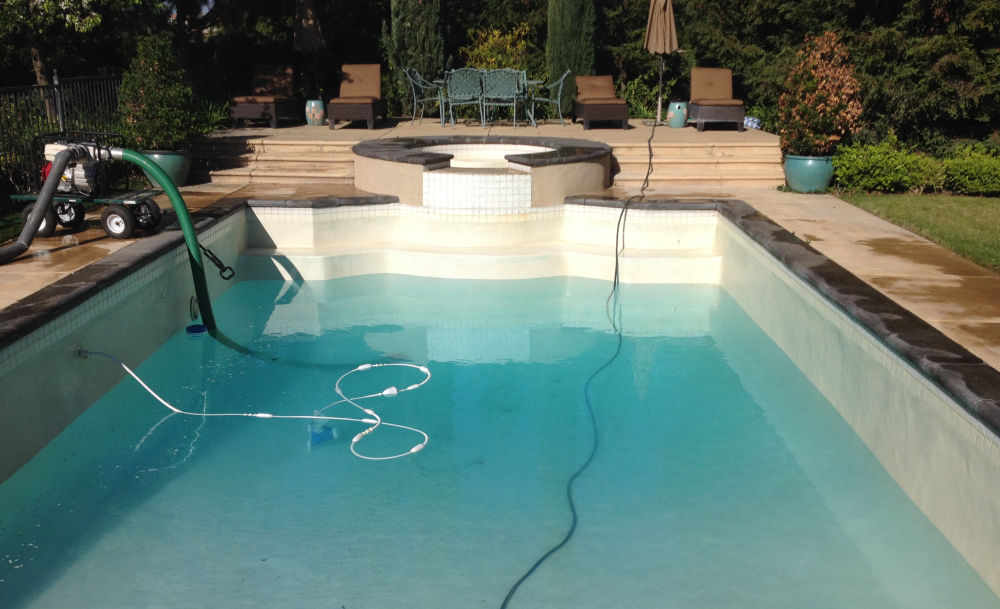If you think that pool draining is as easy as pulling a plug or starting a siphon, think again. Draining a pool incorrectly could damage your pool, your yard, or even nearby properties.
There are several instances where a swimming pool might need a fresh, clean slate. Pool draining is needed for repairs or maintenance that can’t be performed underwater or if the quality of the pool water is unfavorable beyond resolution.
Pool draining is often needed at least every five years. While pool draining may seem to be an easy task to do, you need to be careful in draining because some types of pools aren’t meant to be drained, specifically fiberglass and vinyl pools.
Before you go and drain your pool, make sure you know what you are doing to avoid encountering any problems that might cause damage.
If the chemical balance of your pool water has gotten so out of hand, you need to reset the water. This is normal and happens at least once for every pool owner.
No matter how regularly cleaned or maintained your pool is, the remnants of chemicals combined with debris, dirt, and other contaminants can build up and become total dissolved solids (TSDs).
Once you have these accumulated in your swimming pool, it could seriously mess up your water’s chemistry. The solution to this problem is pool draining.
Having a high-quality pool pump can help lower the need to drain your pool every so often.
When it comes to pool equipment, investing in high-quality parts is always a good idea, especially if you are planning to save money from repairs in the long term.
While most pool cleaning and maintenance services can be performed with water still in it, there are still some specific instances when cleaning and/or maintenance requires an empty pool.
Such cases include cleaning extreme metal stains, calcium deposits, repairing a pool’s cracked floor, repaint the pool floor, etc.

Before you start siphoning water out of your pool, make sure that you get in touch with your local authorities and pool care professionals.
Why?
It’s because many municipalities have their own rules about when, how, and where someone can drain their pool; and as we all know, rules must be followed.
There are certain municipalities that will need you to run pool water through the home’s sewer cleanout line so that it directly flows into a water treatment plant.
Others might also require you to send the water from the pool draining into the storm drains lined on your street.
Some municipalities may also have water chemical composition regulations or require water to be chlorine neutral. In this case, a chlorine neutralizer is needed before draining your swimming pool.
Some municipalities also have rules on when pool draining is allowed. Schedules for pool draining are needed to prevent streets and sewers from being flooded with pool water, especially during rainy seasons.
Other timing considerations are also important. The intense summer heat can destroy a pool liner if it is not submerged in water for quite some time.
The frozen ground brought about by winter can push an empty pool upward, also referred to as “pool pop.”
Before you consider pool draining, you need to wait for dry weather, maybe in the spring or fall, where the daytime highs won’t exceed 85 degrees and the water table is low.
There are also different approaches to pool draining, depending on whether it is an in-ground pool or an above-ground pool.
“Pool pop” is a common term used to describe a scenario where an in-ground pool is drained and the underground pressure heaves the empty pool upward.
This phenomenon may also occur when an in-ground pool is emptied after a heavy, steady rain. Since the soil and water weigh more than the empty pool, the ground literally “pops” upward, which could cause a lot of damage to the pool structure.
Incorrect pool draining may also make the pool pop, specifically draining the water not too far away from the pool. In this case, the water drained is essentially staying around the pool, creating hydrostatic pressure that may trigger the pool out of the ground.
Pool draining requires a game plan (if you plan on going DIY). However, working with pool care experts for pool draining is a better idea. Keep in mind that pool draining involves thousands of gallons of water that’s got to go somewhere.
You just can’t carelessly pull the drain and expect the pool water to simply flow into the street or your neighbor’s backyard.
Having the pool water flow into your yard or garden is also not a viable option unless you would want chemically-treated water to water your plants.
Pool pops are also something that you need to avoid and the first thing to steer away from this problem is to make sure that you don’t introduce water to the ground near your pool.
As we mentioned earlier, you need to schedule a consultation with your local water authority if you are planning on draining your swimming pool. Typically, pool draining would involve directing the water into one of your home’s sewer pipes.
In some cities, they allow pool owners to directly drain into the street. The best thing you need to do is to reach out to your local water authority and discuss the regulations to avoid any hitches along the way.
Pool draining woes? We got your back!
Bryte Pools offers pool draining services in Las Vegas and nearby areas.
To know more about pool draining and other services we offer, feel free to give us a call!